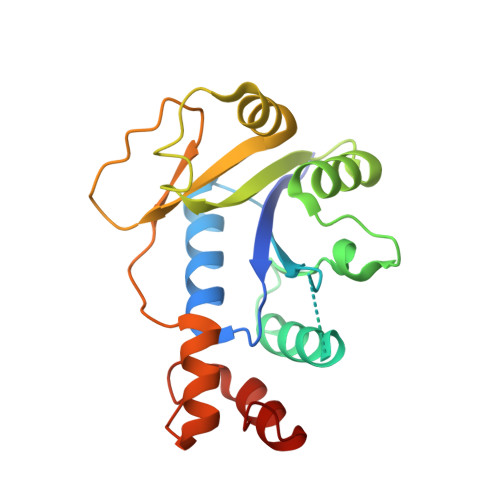Identification, characterization, and crystal structure of Bacillus subtilis nicotinic acid mononucleotide adenylyltransferase.
Olland, A.M., Underwood, K.W., Czerwinski, R.M., Lo, M.C., Aulabaugh, A., Bard, J., Stahl, M.L., Somers, W.S., Sullivan, F.X., Chopra, R.(2002) J Biological Chem 277: 3698-3707
- PubMed: 11704676
- DOI: https://doi.org/10.1074/jbc.M109670200
- Primary Citation of Related Structures:
1KAM, 1KAQ - PubMed Abstract:
The nadD gene, encoding the enzyme nicotinic acid mononucleotide (NaMN) adenylyltransferase (AT), is essential for the synthesis of NAD and subsequent viability of the cell. The nadD gene in Bacillus subtilis (yqeJ) was identified by sequence homology with other bacterial nadD genes and by biochemical characterization of the gene product. NaMN AT catalyzes the reversible adenylation of both NaMN and the nicotinamide mononucleotide (NMN) but shows specificity for the nicotinate. In contrast to other known NMN ATs, biophysical characterizations reveal it to be a dimer. The NaMN AT crystal structure was determined for both the apo enzyme and product-bound form, to 2.1 and 3.2 A, respectively. The structures reveal a "functional" dimer conserved in both crystal forms and a monomer fold common to members of the nucleotidyl-transferase alpha/beta phosphodiesterase superfamily. A structural comparison with family members suggests a new conserved motif (SXXXX(R/K)) at the N terminus of an alpha-helix, which is not part of the shared fold. Interactions of the nicotinic acid with backbone atoms indicate the structural basis for specificity.
- Wyeth-Ayerst Research, Department of Biological Chemistry, Cambridge, Massachusetts 02140, USA.
Organizational Affiliation:
















